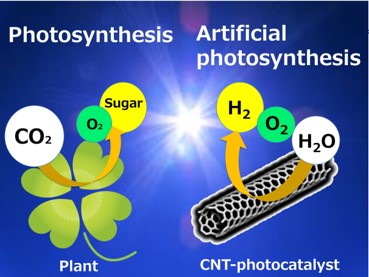Example
CO2-free hydrogen production by the use of CNT-photocatalyst and solar energy
Background
The looming global threat of increasing levels of atmospheric greenhouse gasses renders sustainable sources of energy that do not emit carbon dioxide a prerequisite for a prosperous future of humanity. Today more and more focus is on using ”H2 as a source of energy”. Since most of the hydrogen on Earth exists as compounds like water, H2 does not exist naturally on Earth. H2 must be produced from other compound. Artificial photosynthesis has attracted considerable interest due to its potential for CO2-free production of H2 from water by utilizing abundant solar light energy. However, the active wavelength of the photocatalytic water splitting are not at satisfactory level.
Expected effect
Carbon nanotubes (CNTs) are quite efficient light absorbers from the viewpoint of solar energy harvesting. We have demonstrated the production of H2 of the overall water splitting based on CNT-photocatalyst, which shows high efficiency under NIR-light illumination. Further studies on the applications of CNT-photocatalyst are currently in progress. A Z-scheme photocatalytic system based on CNT-photocatalyst shows a production of H2 and O2 under illumination from a solar simulator with a solar-to-hydrogen (STH) efficiency of 0.089%. Further studies on the applications of CNT-photocatalyst are currently in progress.


Representative
